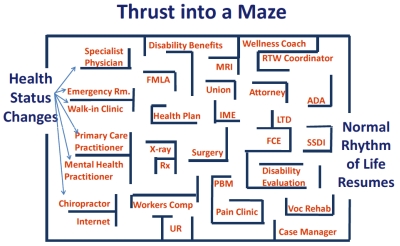 Instead, this important task
typically defaults to the person with the health problem, who is usually the least qualified to carry them out, given the complexity
of todayís health, disability benefits and workersí compensation systems.
Instead, this important task
typically defaults to the person with the health problem, who is usually the least qualified to carry them out, given the complexity
of todayís health, disability benefits and workersí compensation systems.
The Challenge
Assuring a good "big picture" outcome for a working person with a health-related life and employment disruption is not in any professionalís job description today. With rare exceptions, no professional feels responsible for making sure a personís recovery is as complete and rapid as possible, and that the process that determines whether, when and how someone will stay at work and return to work is successfully conducted.
 Instead, this important task
typically defaults to the person with the health problem, who is usually the least qualified to carry them out, given the complexity
of todayís health, disability benefits and workersí compensation systems.
Instead, this important task
typically defaults to the person with the health problem, who is usually the least qualified to carry them out, given the complexity
of todayís health, disability benefits and workersí compensation systems.
As a result, some people fall through this gap in the social fabric and end up with sub-par outcomes that could have been avoided. Insurers say privately that many of their highest cost cases began as common health conditions, ones that most people can find a way to live with. Under certain circumstances, they slowly transform into "creeping catastrophes."
In our view, something is wrong whenever a working person dealing with an illness, injury or other health condition: